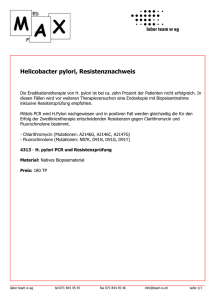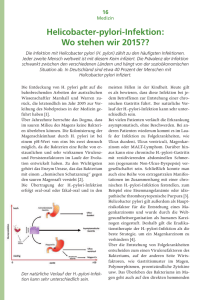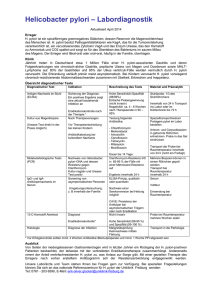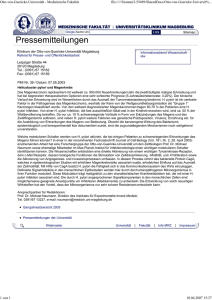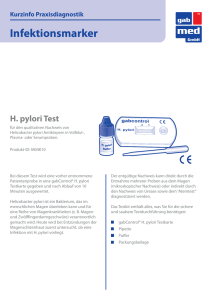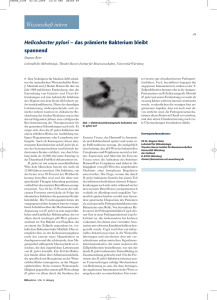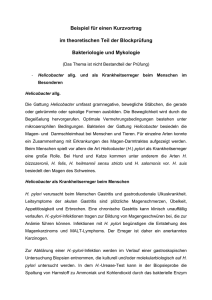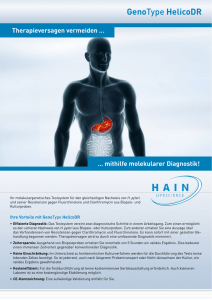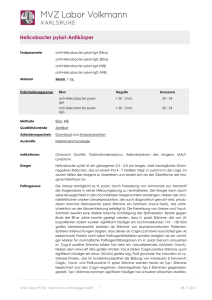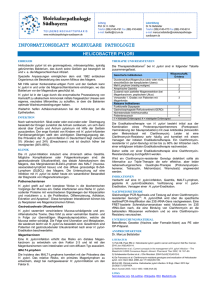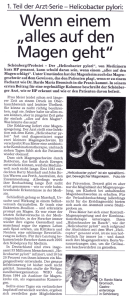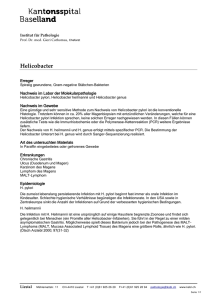H. pylori Atrophische Gastritis
Werbung
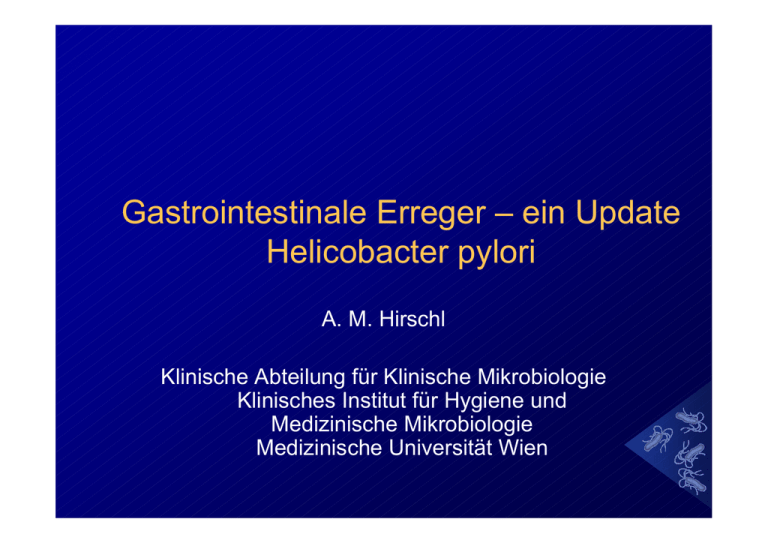
Gastrointestinale Erreger – ein Update Helicobacter pylori A. M. Hirschl Klinische Abteilung für Klinische Mikrobiologie Klinisches Institut für Hygiene und Medizinische Mikrobiologie Medizinische Universität Wien Verlauf der H. pylori Infektion Akute Gastritis • Bakterielle Faktoren • Wirtsfaktoren Chronische Gastritis Antrum prädominant Multifokale Atrophie Ulcus duodeni (Alter 20-40) Ulcus ventriculi (Alter 40-70) Magen Karzinom (Alter > 70) H. pylori –Assoziation mit gastrointestinalen Erkrankungen • Bis zu 50% der Infizierten → Atrophische Gastritis • Bis zu 10% der Infizierten → Peptisches Ulkus • 1-2% der Infizierten → Magenkarzinom Kuipers, ATP 1999 H. pylori und Magensäure ECL-Zellen Histamin + - + G-Zellen (Antrum) Gastrin Vagus Acetylcholin ParietalZellen Magensäure Magen pH ↓ D-Zellen (Antrum) Somatostatin + - 3 Phänotypen der H. pylori-Infektion • Milde Pangastritis ohne wesentliche Störung der Magenphysiologie und ohne signifikante Erkrankung • Magenkarzinomtyp: Corpus dominante Gastritis mit Atrophie und Hypochlorhydrie • Ulcus duodeni-Typ: Antrum dominante Gastritis mit Hyperchlorhydrie Bakterielle Faktoren (Beispiele) • • • • Cag-Pathogenitätsinsel Vakuolisierendes Zytotoxin (Vac A) Säureresistenz (Urease) Adhäsion und äußere Membranproteine – – – – Bab A Oip A Sab A Ice A • Lipopolysaccharid Cag-Pathogenitätsinsel Kusters et al, Clin Microbiol Rev 2006 Wirt-spezifische Faktoren (Beispiele) • Immunantwort • Genpolymorphismen – – – – IL-1 Gencluster IL-8 IL-10 TNF-α Assoziation von DU mit der Anzahl regulatorischer T-Zellen in der Magenschleimhaut Robinson et al, Gut 2008 Interleukinpolymorphismen und Magenkarzinom El Omar et al, Nature 2000 Etablierte Indikationen zur Diagnose und Therapie der H. pylori Infektion • Aktive Ulkuskrankheit (DU, GU) • Anamnese eines DU od. GU ohne bisherige Eradikationstherapie • Dyspeptische Beschwerden • MALT-Lymphom des Magens Maastricht II-2001 Maastricht III-2005 Am Coll of Gastroenterol Guidelines 2007 Ford et al, Cochran Review 2003 Häufigkeit der Ulkusblutung nach erfolgter Eradikationstherapie Anzahl Studien Anzahl Patienten Blutung (%) Follow up Patienten-Jahre Blutung jährlich % 30 1650 21 (1,3%) 2886 0,8 Gisbert et al, Helicobacter 2007 H. pylori und dyspeptische Beschwerden • 10% relative Risikoreduktion (95%CI 6-14%) beim Eradikationstherapie vs. Placebo • NNT = 14 • „test and treat“ Strategie in KonsensusKonferenzen empfohlen • Zusätzlicher Nutzen: PUD↓, GC↓ Cochrane Meta-Analyse randomisierter kontrollierter Studien zur H.pylori-Eradikation bei Patienten mit Dyspepsie Moayyedi P et al, Cochran Review 2006 Patient mit Dyspepsie < 45 Jahre keine Alarmsymptome ≥ 45 Jahre Alarmsymptome HP-Prävalenz ≤ 20% HP-Prävalenz > 20% PPI „test and treat“ Versagen „test and treat“ PPI Versagen Endoskopie H. pylori und MALT Lymphom • Niedrig malignes MALT Lymphom – – – – Inzidenz: 1/100000 92-98% H. pylori assoziiert Heilungsrate 50-100% (E I1>E I2>EII) Kumulative Rezidivrate: 12% nach 3 Jahren • Hoch malignes MALT Lymphom – Komplette Remission in 64% – Rückfallrate 0% Kontroversielle Indikationen zur Diagnose und Therapie der H. pylori-Infektion • • • • • • Refluxkrankheit NSAID-Therapie Prophylaxe des Magenkarzinoms Ungeklärte Eisenmangel Anämie Ideopathische thromb. thrombozyt. Purpura Andere extragastrointestinale Manifestationen Maastricht II-2001 Maastricht III-2005 Am Coll of Gastroenterol Guideline 2007 H. pylori und Refluxkrankheit • Prävalenz von H. pylori niedriger bei Patienten mit Refluxkrankheit • In westlichen Ländern H. pylori ↓ Reflux + Komplikationen ↑ • H. pylori reduziert das Risiko von Reflux, Barrett‘s Ösophagus und Adenocarcinom um ca. 50% • Eradikationstherapie bei Langzeit-PPI Verabreichung erwägen Zusammenhang zw. H. pylori/Magenatrophie und Adenocarcinom des Ösophagus, Barrett-Ösophagus und Refluxösophagitis OAC BO RO 0,52 (0,34-0,80) 0,41 (0,27-0,62) 0,42 (0,28-0,64) 0,92 (0,45-1,91) 0,13 (0,04-0,44) 0,17 (0,06-0,54) H. pylori positiv OR (95%CI) Atrophie positiv OR (95%CI) Anderson et al, Gut 2008 Atrophische Gastritis und H. pylori Infektion bei Patienten unter Langzeit PPI-Therapie H. pylori Atrophische Gastritis vor PPI nach PPI negativ 0/46 (0%) 2/45 (4%) positiv 0/59 (0%) 18/59 (31%) Kuipers et al, NEJM 1996 H. pylori und NSAID • H. pylori und NSAID sind unabhängige Risikofaktoren für PUD und Blutung • Additiver bis synergistischer Effekt • Eradikationstherapie vor Beginn einer NSAIDTherapie empfehlenswert • Bei Patienten unter NSAID-Langzeittherapie mit Ulcus u./o. Blutung ist eine Eradikationstherapie alleine nicht ausreichend • Bei Patienten unter Langzeittherapie mit Aspirin und Ulcus u./o. Blutung eine Eradikationstherapie durchführen Mögliche Indikationen zur Eradikationstherapie im Rahmen der Karzinomprophylaxe • Nach endoskopischer Resektion eines Magenkarzinoms • Verwandte ersten Grades von Patienten mit Magenkarzinom • Populationen mit hohem Ca-Risiko (>20/100000) H. pylori und Magenkarzinom (1) Uemura et al (NEJM, Sept. 2001) – Karzinomhäufigkeit (∅ 7,8 Jahre): 36/1246 (2,9%) H. pylori pos. Pat. 0/280 (0%) H. pylori neg. Pat. p < 0,001 Helicobacter and Cancer Collaborative Group (Gut, Sept. 2001) – Kombinierte Analyse von 12 prospektiven Studien – Relatives Risiko (H. pylori pos. vs. neg.) für Magenkarzinom: 5,9 – 65-80 % des Magenkarzinoms durch H. pylori hervorgerufen Wang et al (JAMA, Jan. 2004) – Interventionsstudie in China (1630 Pat., follow up 7,5 Jahre) – Gesamt: 7 und 11 Fälle, (behandelt/unbehandelt; p=0,33) – Bei Patienten ohne präkanzeröse Läsion (n=988): 0 und 6 Fälle (behandelt/unbehandelt; p=0,02) H. pylori und Magenkarzinom (2) • Wang et al (Am J Gastroenterol 2008) – Metaanalyse von 19 Fall-Kontrollstudien – H. pylori Prävalenz signifikant höher bei Patienten mit Magenfrühkarzinom (87,3%) vs. Kontrollen (61,4%): OR 3,4 (95% CI: 2,2-5,3) • Talley et al (Am J Gastroenterol 2008) – Pooled RR der Entwicklung einer GC nach H. pylori Eradikation: 0,56 (95% CI: 0,4-0,8) Asia-Pacific consensus guidelines on gastric cancer prevention (Nov. 2006) • Screening in Hochrisikoländern 10-20 Jahre vor Anstieg der GC-Inzidenz • Screening bei Kindern nicht empfohlen • Serologie als Screening • Therapie basierend auf nationalen Richtlinien • Zusätzliche Vorteile: PUD ↓, NUD ↓, Kosten (Endoskopie, PPI) ↓ • Mögliche Risiken: Resistenz ↑, CD-Colitis ↑ Fock et al, J Gastroenterol Hepatol 2008 Initialtherapie zur Behandlung der Infektion mit H. pylori (Maastricht III-2005) PPI + Clarithromycin 2x Standarddosis Amoxicillin + 2x 500 mg 2x 1000mg oder PPI 2x Standarddosis + Clarithromycin 2x 500 mg Metronidazol + 2x 400 mg oder PPI Wismut + 2x Standarddosis Tetracyclin + 4x 120 mg Therapiedauer: 7-14 Tage Metronidazol + 4x 500 mg 3-4x 400-500 mg Heilungsraten mit Dreiertherapie H. pylori eradication with triple therapy according to clarithromycin/metronidazole susceptibility and resistance Megraud, Gut 2004 Distribution of primary resistance of H. pylori to antibiotics in different European centres, 1998 Evaluation of resistance (%) to clarithromycin by geographical region and country of origin 20 18,4 18 16 14 12 10 9,8 9,3 8 6 4,2 4 2 0 Global North Glupczynski et al, Eur J Clin Microbiol Inf Dis, 2001 Central/ East South Outpatient macrolide and lincosamide sale in 1997 in the European Union Cars et al, Lancet 2001 Primary resistance of H.pylori to various antimicrobial agents in various parts of Europe in adult patients Temporal trends of developement of resistance in untreated patients M. Kist, ResiNet 2008 Prospective multicentre study on antibiotic resistance of H. pylori from paediatric patients in Europe Koletzko et al, Gut 2006 The prevalence of primary H. pylori resistance against clarithromycin in children and adolescents Vienna 1996-2007 Sequenztherapie zur Eradikation von H. pylori • PPI / 2x tgl; ½ h vor dem Frühstück und Abendessen • Amoxicillin / 1000 mg 2x tgl. nach dem Frühstück und Abendessen • PPI / 2x tgl; ½ h vor dem Frühstück und Abendessen • Clarithromycin / 500 mg 2x tgl. nach dem Frühstück und Abendessen • Tinidazol / 500 mg 2x tgl. nach dem Frühstück und Abendessen 5 Tage 5 Tage Meta-Analyse: Sequenztherapie vs. StandardDreiertherapie bei initial unbehandelten Patienten Anzahl Eradikation (%) Patienten Studien Sequ.-Ther. Stand.-Ther. Alle Studien 2247 10 93,4 76,9 Jadadscore ≥ 3 841 5 92,8 79,1 Diagnose PUD 416 4 97,5 79,8 Diagnose NUD 1083 4 91,9 73,2 Jafri et al, Ann Intern Med 2008 H. pylori Eradikation mit sequentieller und Standardtherapie in Abhängigkeit von der Empfindlichkeit gegenüber Clarithromycin Zullo et al, Gut 2008 Einschränkungen zur sequentiellen Therapie • Studien mehrheitlich in einem Land (Italien) durchgeführt • Kompliziertes Einnahmeschema • Meta-Analyse zeigt signifikanten „publication bias“ Weitere Alternativen zur Primärtherapie • Wismuth enthaltende Quadruple Therapie – – – – Wismuth (3-4x) Tetrazyklin-hydrochlorid (3-4 x 500 mg) Metronidazol od. Tinidozol (3 x 500 mg od. 4 x 250 mg) PPI (2 x Standarddosis) • Wismuth freie Quadruple Therapie – – – – PPI ( 2 x Standarddosis) Amoxicillin ( 2 x 1000 mg) Metronidazol od. Tinidazol ( 2 x 500 mg) Clarithromycin 2 x 500 mg) • Hochdosierte Dualtherapie • Therapiedauer 7-14 Tage Randomisierte Vergleichsstudie: Sequentielle vs. Wismuth-freie Quadruple Therapie • 123 Patienten (Taiwan) • Sequentielle Therapie: 10 Tage • Quadruple Therapie 7 Tage Eradikation (%) Nebenw. (%) Compliance (%) Therapie ITT PP Sequenz 89 93 12 94 Quadruple 87 91 16 94 Wu et al,Gastroenterology 2008 Optionen nach Therapieversagen • Antibiogramm-basierte Therapie! • Bismuth-Quadrupletherapie • PPI (2 x Standarddosis) Amoxicillin (2 x 1000 mg) + Levofloxacin (2 x 250 mg) oder Rifabutin (2 x 150 mg) oder Furazolidon (2 x 100-200 mg) • Therapiedauer 7-14 Tage
